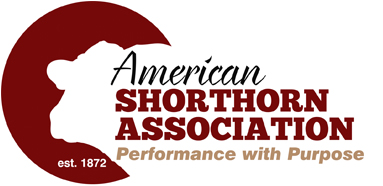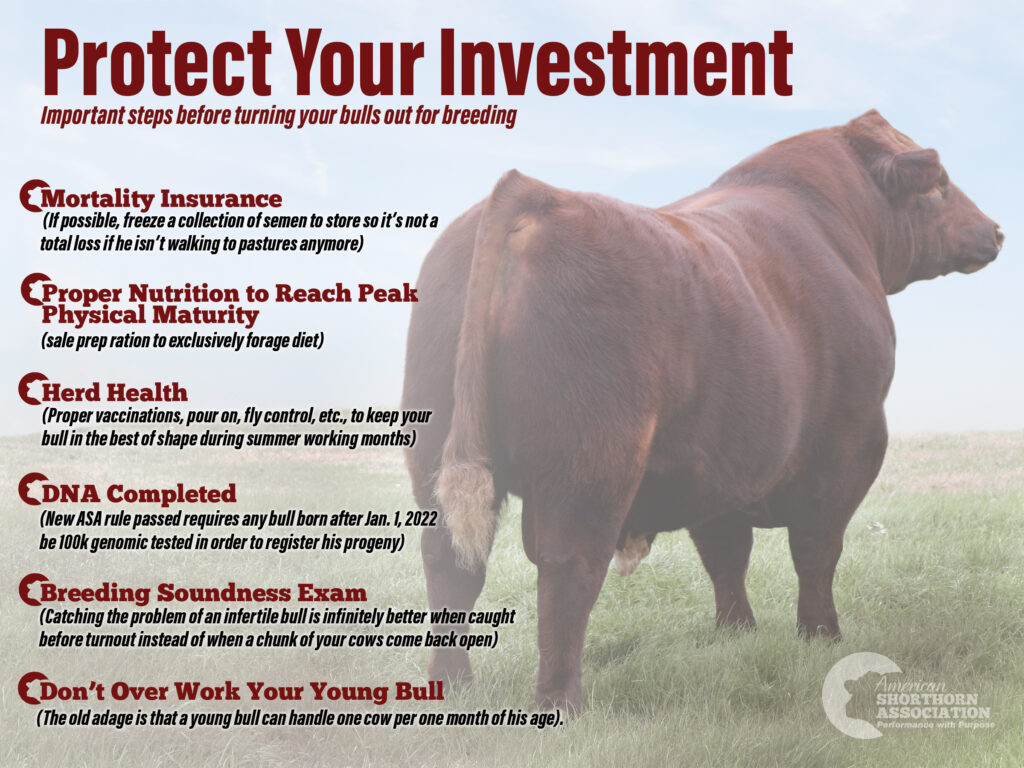This time of year, a lot of money is being invested in future herd sires for both Shorthorn breeders and commercial producers. Plenty of preparations go into making the selection of your next bull, and we all enjoy the thrill of winning the bid at auction or striking the deal private treaty. However, the purchase is merely the beginning. You want to protect your investment to maximize his return to your operation, and proper considerations need to be taken to maximize the performance of your newest team member while attempting to minimize your risk.
The first step to minimize your risk in this purchase is making the decision regarding mortality insurance on your new purchase. We all know accidents happen, and it seems that Murphy’s Law (if it can happen, it will) most directly corresponds to the best animals in the herd. I would anticipate that if you brought in a new young bull, he’s probably going to be one of your better prospects, and the small insurance premium (usually 6% of purchase price) is worth the peace of mind it brings that you are financially covered if the new guy does the unthinkable during his first breeding season. If at all possible, freezing a collection of semen to store can be viewed as an ”insurance policy” that the bull’s genetic power isn’t totally lost if he isn’t walking the pastures.
It’s important to remember if you bought a yearling bull, you bought the bovine equivalent of a teenage boy. They are still growing and developing, and they need the nutrition to help them reach peak physical maturity. Getting a bull into the right shape for breeding season might require losing some extra sale day condition before turnout. Going from a sale prep ration to breeding cows out on pasture could be a bit of a shock to the system if you don’t help your bull transition to that exclusively forage diet.
Whatever your usual herd health protocol includes, it’s important to get your bull on the same program as the rest of the herd as soon as you can. Visit with the seller of the bull to see what measures they may have taken for herd health while he was still in their care. Proper vaccinations, pour on, and even fly control can be important to keeping your bull in the best of shape during the summer working months.
Before turnout, check to make sure that the proper DNA work has been done on your new bull. With the ruling passed by the ASA Board of Directors in 2022, any bull that you buy born on or after January 1, 2022 will need to be 100K genomic tested with ASA in order to register his progeny. You can log in to Digital Beef to see if he has been tested by the seller before you take possession. If his EPDs are highlighted in yellow, you are good to go. If not, you need to grab a DNA sample while he is still around the barn and it is handy to get.
In most cases, the seller of the bull will guarantee you that he will pass a breeding soundness exam (BSE). If the bull has not had a BSE at the time you purchase him, it is absolutely vital to have your veterinarian perform one before you turn him out. Catching the problem of an infertile bull is infinitely better when caught before turnout instead of when a chunk of your cows come back open. Most sellers will do everything they can to make the deal right if your new bull does pass a BSE and isn’t deemed fit to breed cows. It’s something you never want to have to discuss, but make sure you and the seller are clear on expectations from both sides if the bull isn’t a breeder. Refunds, sale credits, or replacement bulls are all ways I have seen this handled. Both sides need to be ok with whatever arrangement is struck.
Now that you’ve got him insured, fed right, as healthy as can be, and certified to be fertile, it’s time to put the new guy to work. It’s important to not put too much workload on your young bull in his first breeding season. Sometimes we forget that young bulls aren’t machines. They are being asked to grow, mature, and breed cows all at once, making it a tough stage of life. The old adage is that a young bull can handle one cow per one month of his age. If you are using him in a cleanup situation behind a round of AI, you can probably increase this number a little bit, provided you are getting decent conception rates with artificial insemination.
The perfect recipe for disaster when you bring home a new, young herd bull is to drive him to the pasture, open the gate, and kick him out with 40 cows and wish him well. You take proper care of the other major investments around your farm (tractors, pickups, hay balers). Your bull should be no exception, as he is a major investment in the future of your genetics. Taking the extra steps early on in his development can make the difference between sending your bull to town after one or two breeding seasons or having him properly developed to still walk the pastures at a ripe old age.
written by Matt Woolfolk, ASA Director of Performance Programs





![[ Random Image ]](/wp-content/themes/shorthorn/headers/header10.jpg)
